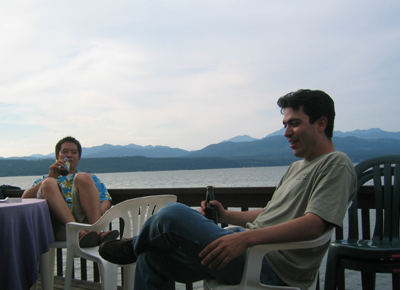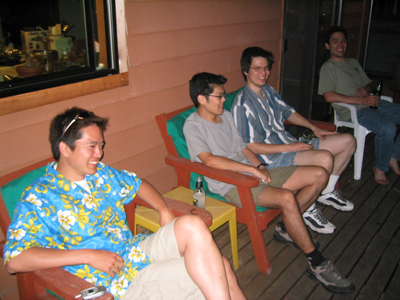

I made the guys get up early and get out the door. We had to drive all the way to Olympia to get some of the parts we needed, and I wanted to be back before 10:00am in case people started showing up then. We had to go to a couple different stores, and didn't get back until around 11:00. I was worried that people might have shown up, or maybe called asking for directions while we were gone. It turns out I didn't need to worry. As we were arriving back in Union, everyone else was just getting ready to leave Seattle.
When they finally called at about 1:00pm and said they were just getting on the ferry, we figured we better get started building the guns, or they wouldn't be ready for Sunday. Carl really love to build things, and he and I did most of the work designing and constructing the two cannons. noth that htere was a huge amount of design work. We studied designs and pictures of working cannons on the internet, then got to work.


The guys showed up around 4:30. They brought the last of the parts, which I had ordered from Spudtech.com, a website that specializes in custom PVC products specifically for potato guns. These were heavy 2" barrels, with rifling inside. To rifle a gun barrel, grooves are cut in the inside that spiral down its length. When a projectile is fired, the grooves set it to spinning, which gives the projectile a more stable flight. It may seem like overkill to do that to a potato gun, but well, building a potato gun is itself overkill.
We all enjoyed some beer and the view of the canal and the Olympic mountains. John and Eugene barbaqued up some regular ribs and then some Korean karubi ribs. It was a great dinner.


Someone thought it would be a good idea to have a target to shoot at, so we put the rowboat in the water and sent out a two man team to be human targets. Believe it or not, most everyone was still sober when this plan was developed. Dante and John and Bullet took turns rowing around in front of my grandma's house, while everyone else took turns shooting at them. It quickly became apparant that it was impossible to accurately hit anything. The boaters took a garbage can and a cooler lid to use as shields should any potatos actually hit them, but they didn't need them at all. I don't think anyone ever got closer than about 20 yards to the boat, and that only happened once.
It got too dark to shoot or row a boat, so we retired to the deck for a pleasant evening of beer and conversation. Dante had come all the way from British Columbia to join us. Did you know that in B.C. possesion of pot is only a misdemeanor? I hear it's really easy to get pot there. I'm not saying anything else about that. Check out the picture of Wayne below and draw your own conclusions.




After sending a bunch of spuds onto the mudflats, we decided to try some close range target practice. Even at a range of 20 yards, it was hard to be precise. Not only did we have trouble hitting the X spot on this sheet of particle board, we missed it entirely several times.


Well, when Eugene pumped the pneumatic cannon up to 30 psi and it didn't explode, in true engineer's fashion, he figured it would be safe at 40 psi. The book we had on potato guns ( yes, there is an actual book on the subject) said never set the pressure over 30 psi. Eugene hadn't read that part. Several shots later, he had the pressure up around 70 psi. It shot a potato clean through the board! That was when Carl and I asked what pressure he was using. We talked him out of continuing his stress test, and we dialed back down to 40 psi for the rest of the day. The rest of the day turned out to be not so long, however.


We ate a nice lunch of barbaqued pork chops with Jamaican jerk seasoning, courtesy of Wayne. Then it was time to go home. We convoyed through some truly crappy traffic, as everyone and his dog returned home from a spectacularly sunny weekend in the Northwest. The guns are in my garage now, but I can't really shoot them off in Seattle. I'm not sure when I'll get another chance to lauch some spuds a couple hundred yards into the air, but I can't wait.